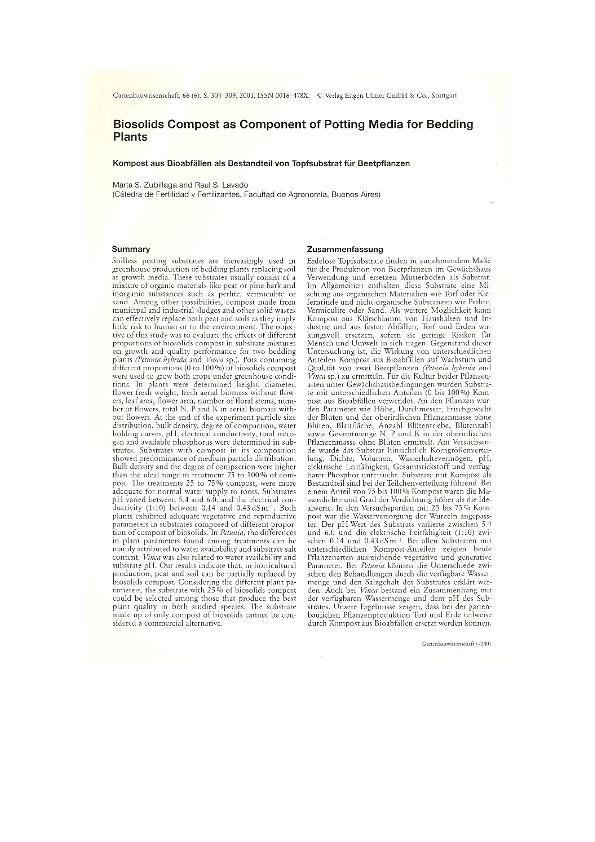Mostrar el registro sencillo del ítem
dc.contributor.author
Zubillaga, Marta Susana

dc.contributor.author
Lavado, Raul Silvio

dc.date.available
2018-09-11T22:01:35Z
dc.date.issued
2001-11
dc.identifier.citation
Zubillaga, Marta Susana; Lavado, Raul Silvio; Biosolids compost as component of potting media for bedding plants; Eugen Ulmer Gmbh Co; Die Gartenbauwissenschaft; 66; 6; 11-2001; 304-309
dc.identifier.issn
0016-478X
dc.identifier.uri
http://hdl.handle.net/11336/59249
dc.description.abstract
Soilless potting substrates are increasingly used in greenhouse production of bedding plants replacing soil as growth media. These substrates usually consist of a mixture of organic materials like peat or pine bark and inorganic substances such as perlite, vermiculite or sand. Among other possibilities, compost made from municipal and industrial sludges and other solid wastes can effectively replace both peat and soils as they imply little risk to human or to the environment. The objective of this study was to evaluate the effects of different proportions of biosolids compost in substrate mixtures on growth and quality performance for two bedding plants (Petunia hybrida and Vinca sp.). Pots containing different proportions (0 to 100 %) of biosolids compost were used to grow both crops under greenhouse conditions. In plants were determined height, diameter, flower fresh weight, fresh aerial biomass without flowers, leaf area, flower area, number of floral stems, number of flowers, total N, P and K in aerial biomass without flowers. At the end of the experiment particle size distribution, bulk density, degree of compaction, water holding curves, pH, electrical conductivity, total nitrogen and available phosphorus were determined in substrates. Substrates with compost in its composition showed predominance of medium particle distribution. Bulk density and the degree of compaction were higher than the ideal range in treatment 75 to 100 % of compost. The treatments 25 to 75 % compost, were more adequate for normal water supply to roots. Substrates pH varied between 5.4 and 6.0, and the electrical conductivity (1:10) between 0.14 and 0.43 dS m–1. Both plants exhibited adequate vegetative and reproductive parameters in substrates composed of different proportion of compost of biosolids. In Petunia, the differences in plant parameters found among treatments can be mainly attributed to water availability and substrate salt content. Vinca was also related to water availability and substrate pH. Our results indicate that, in horticultural production, peat and soil can be partially replaced by biosolids compost. Considering the different plant parameters, the substrate with 25 % of biosolids compost could be selected among those that produce the best plant quality in both studied species. The substrate made up of only compost of biosolids cannot be considered a commercial alternative
dc.format
application/pdf
dc.language.iso
eng
dc.publisher
Eugen Ulmer Gmbh Co

dc.rights
info:eu-repo/semantics/openAccess
dc.rights.uri
https://creativecommons.org/licenses/by-nc-sa/2.5/ar/
dc.subject
Greenhouse
dc.subject
Substrates
dc.subject.classification
Agricultura

dc.subject.classification
Agricultura, Silvicultura y Pesca

dc.subject.classification
CIENCIAS AGRÍCOLAS

dc.title
Biosolids compost as component of potting media for bedding plants
dc.title
Kompost aus Bioabfällen als Bestandteil von Topfsubstrat für Beetpflanzen
dc.type
info:eu-repo/semantics/article
dc.type
info:ar-repo/semantics/artículo
dc.type
info:eu-repo/semantics/publishedVersion
dc.date.updated
2018-08-30T16:23:38Z
dc.journal.volume
66
dc.journal.number
6
dc.journal.pagination
304-309
dc.journal.pais
Alemania

dc.journal.ciudad
Stuttgart
dc.description.fil
Fil: Zubillaga, Marta Susana. Universidad de Buenos Aires. Facultad de Agronomía; Argentina
dc.description.fil
Fil: Lavado, Raul Silvio. Consejo Nacional de Investigaciones Científicas y Técnicas. Oficina de Coordinación Administrativa Parque Centenario. Instituto de Investigaciones en Biociencias Agrícolas y Ambientales. Universidad de Buenos Aires. Facultad de Agronomía. Instituto de Investigaciones en Biociencias Agrícolas y Ambientales; Argentina
dc.journal.title
Die Gartenbauwissenschaft
Archivos asociados
